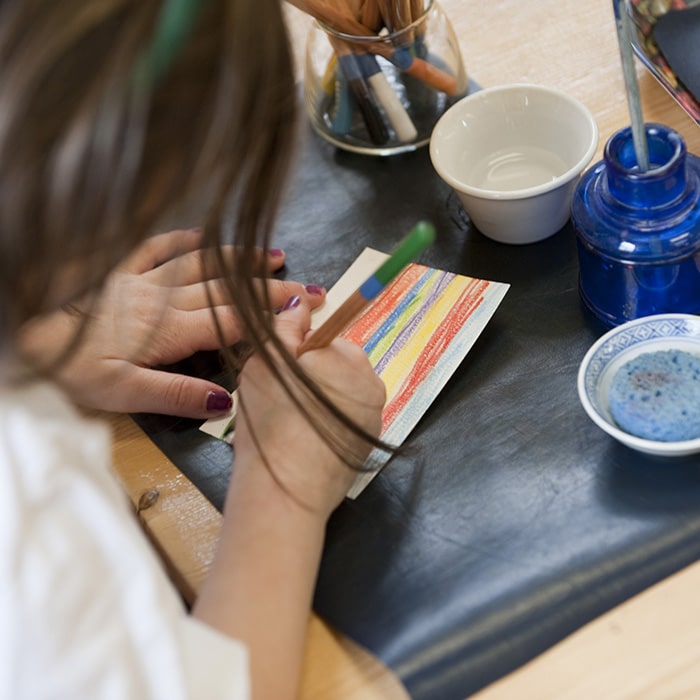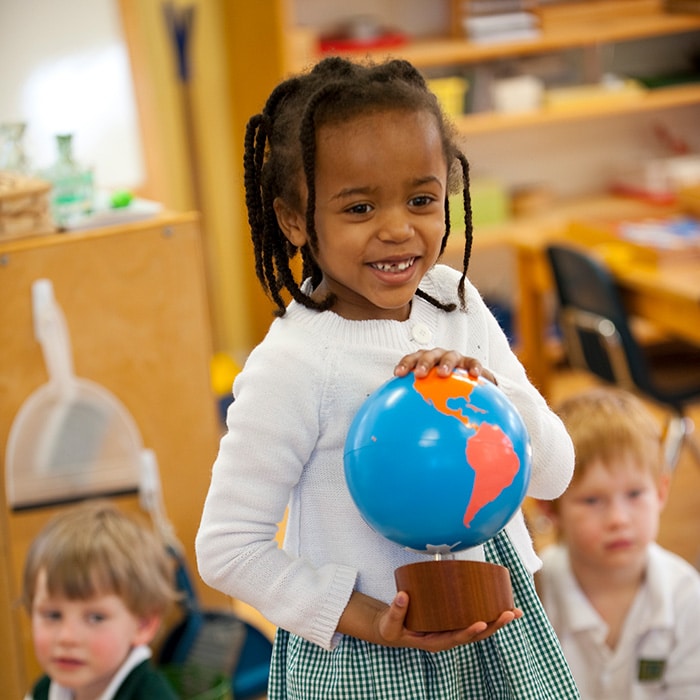Preschool: CASA
“Clanmore checks off all the important priorities: skilled and compassionate teachers, a mastery of Montessori, a beautiful space for learning, and excellent teacher to student ratios.”
Rena Bast, Casa Parent
Preschool: CASA
“Each ordinary school day, unique learning opportunities create an extraordinary experience.”
Mary, Casa Parent
Casa children explore the world, processing information through their senses. The concrete, hands-on materials in our Casa environments respond beautifully to the way in which these children learn.
SOCIAL DEVELOPMENT
Opportunities for the awareness of one’s needs and the needs of others is supported by the “Clanmore Social Curriculum”, based on Diane Gossen’s “Restitution Theory.”
Through discussion and dramatization, helpfulness, love, respect, safety, the need for purposeful work and belonging, are presented. Our Casa curriculum focuses on understanding that all persons have needs, and that disequilibrium of these needs causes conflict, which must be repaired respectfully to reinstate harmony. The independent resolution of conflict is modeled and supported.
PRACTICAL LIFE
The practical life exercises reflect those activities that commonly occurs in the home setting. This sets the stage for purposeful, meaningful work using real-life materials. Each child’s work with these activities provides opportunities for the development of concentration, the coordination of small and large muscle groups, logical sequential thought, and spatial relationships. These skills, in turn, are also required for further exercises in writing, reading, and math, for example.
SENSORIAL
The sensorial materials comprise a series of hands-on activities focusing on visual, auditory, tactile, olfactory, gustatory, and kinesthetic concepts. The visual sense is refined, for example, using geometric shape and colour exercises. Further experiences with classification, categorization, and exploration follow. Observation, comparison, judgement, reasoning, and decision-making skills are all supported by the sensorial materials.
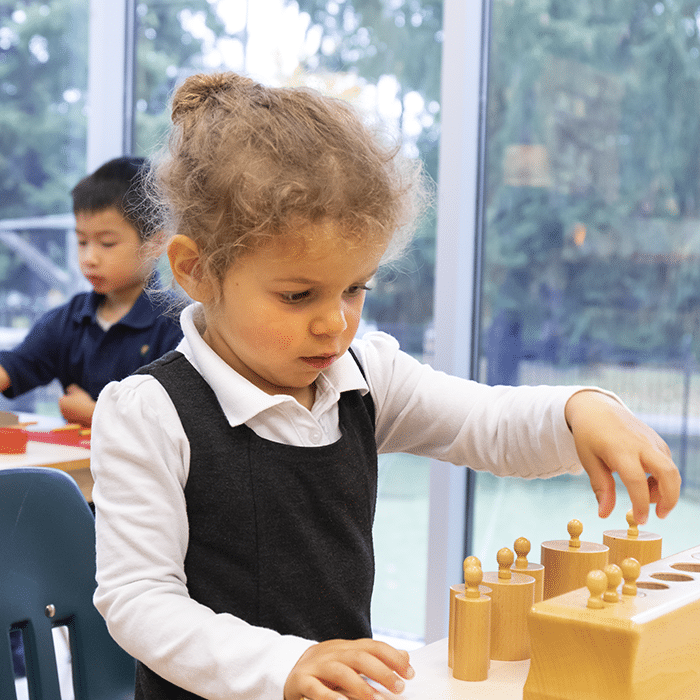
LANGUAGE
The early years are a period of intense language acquisition. Receptive and expressive language skills are nurtured by focusing first on the spoken word, then progressing to writing, followed by reading and the exploration of grammar. The language area builds upon the foundation of concentration, logical sequential thinking, and motor control, nurtured through the practical life and sensorial work.
Spoken language work includes the enrichment of vocabulary (learning the proper names of objects), developing and refining conversation skills, sentence structure, and staying on topic.
Verb tenses are also a focus, with emphasis on the proper use of the past, present, and future tenses. Additionally, poetry, sound rhymes, jingles, stories, and songs also help to foster an appreciation of literature.
Phonological (sound) awareness includes exercises which draw awareness to the beginning, middle and final sounds in words, and the fact that words are amalgamations of sounds.
The sandpaper letters allow for sound symbol association. Cursive letters are used for many reasons, one of which is that letter reversals are eliminated as the cursive letters do not mimic one another in shape or form.
Writing
The moveable alphabet is one of the materials used to facilitate the making of words, followed by the formation of sentences, and eventually paragraphs when the child is ready. Earlier work with the sensorial and practical life materials helps to prepare the hand for writing. The use of chalkboards and metal inset shapes, for example, further prepare the hands for this task. After this period of preparation, paper and pencils are introduced. Cursive writing is used, as it corresponds readily to the child’s natural hand movements and encourages the blending of sounds.
Reading
We begin with phonetic reading using single words on cards. Irregular words are slowly introduced over time. This work is done extensively before the reading of text. Simple text is introduced upon readiness of the child. Even though we write in cursive, reading words are introduced in print form. We find that for most children print letters are easily recognized because the print version of a letter exists visually within the cursive form, but not vice versa.
Phonograms, or letter combinations which create new sounds (sh, ch, oo etc.), are introduced in isolation and incorporated into the child’s compositions with the moveable alphabet. These phonograms also appear in the written texts that are introduced and further aid in reading fluency.
Grammar is also touched upon. Nouns, verbs, articles, adjectives, adverbs, prepositions, and conjunctions are presented with materials that can be used repeatedly and independently by the children to reinforce understanding.
MATHEMATICS
Mathematics is experienced through the use of concrete materials. The children use and manipulate these concrete materials repeatedly to internalize their understanding of the mathematical concepts inherent therein. The skills of concentration, logical and sequential thinking acquired in the practical life, and sensorial activities, all aid the childchildren in their readiness for mathematics.
Formal Mathematic work begins with:
Numbers from 0 – 10
Using rods, spindles and disks, the concepts of length, numbers as quantity, and the use of zero as a place holder are introduced. The concrete example of a number quantity is always
introduced before the symbol that represents it. The thorough exploration and understanding of numbers from 0 – 10 is vital to all further work in mathematics.
Numbers 11-19
The concept of teens is introduced separately from other numbers to reinforce the fact that they are created with the use of one “ten” and a number of units.
Numbers 11-99
These numbers are studied with particular emphasis on the transition from nine to the next ten (39-40, 49-50 etc.) using beads, then beads matched with number cards. When the child demonstrates a solid understanding of number and numeration, they are presented with the further concepts.
Decimal System
The categories of unit – ten, hundred, and thousand – are introduced with the use of bead materials. This leads to the practice of the four arithmetic operations; addition, multiplication, subtraction, and division.
Counting to 1000
The rote counting and recognition of numbers is enhanced with the use of bead chains. This work also presents the children with a visual impression of squaring and cubing.
Memorization Work
Using a series of boards, the children can begin to memorize addition, multiplication, subtraction, and division facts.
Passage to Abstraction
The time the child spends using the concrete math materials is extensive. Repetition allows internalization of the math concepts and leads the way for the future ability to perform mathematical equations without concrete materials. Each child reaches this stage at his/her own readiness, and may return to the concrete materials at any time, if a concept requires reinforcement later on.
Fractions
Segmented circles are used to visually demonstrate the concept of fractions from the whole to tenths. Repeated work with these materials can lead to the introduction of addition, subtraction, multiplication, and division with fractions.
Geometry
The children are exposed early in the Casa years to both plane and three-dimensional geometry. Proper terminology is used. The children are child is encouraged to experiment with shapes, making their own discoveries thus creating a solid foundation for future geometry work.
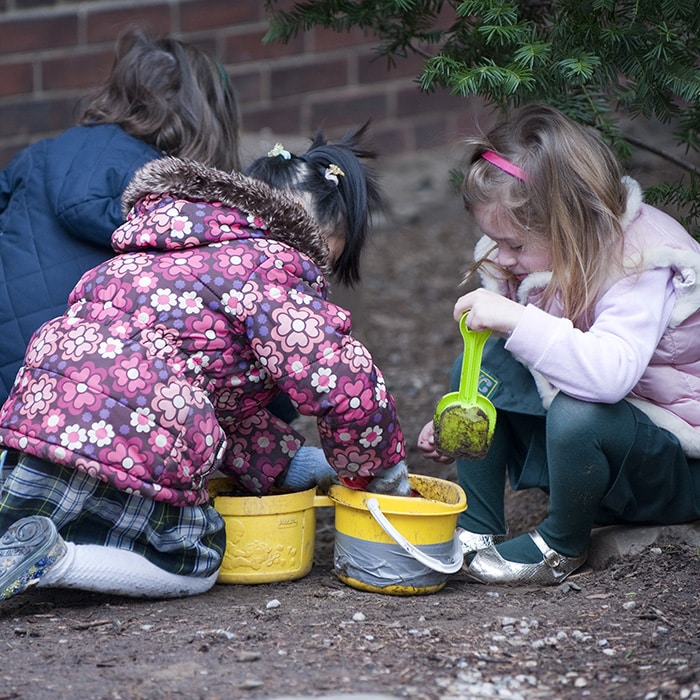
HISTORY
Several activities introduce the child to the concept of time and the passage of time. Concepts such as morning, afternoon, evening, and night, as well as an introduction to the calendar, includingdays of the week and months of the year.
A focus is drawn to personal history through birthday celebrations, with a focused awareness of seasonal change through direct experience, discussion, stories, and picture cards. Conversation incorporates the past, present, and future tenses, and historical figures are explored. For example, artists and composers are introduced through works of art, picture cards, music, and books.
GEOGRAPHY
This area includes an exposure to world cultures, as well as both physical and political geography.
Physical Geography
The concepts of land and water are introduced using globes. Further study includes an introduction to land and water forms including island, lake, cape, bay, peninsula, and gulf. These formations are explored with models, picture cards, books, and maps.
Political Geography
Puzzle maps and flags introduce encourage the concepts of continents, countries, and divisions of areas within countries (provinces, states etc.)
Cultural Geography
Customs, foods, clothing, music, and holiday celebrations are discovered through books, photos, art, and songs, as well as through the celebration of holidays specific to the children in the class.
SCIENCE
Biology
The concepts of living and non-living, and plants and animals are explored with the use of picture cards, books, and real objects in the school environment.
Zoology
Vertebrates and Invertebrates are explored, along with the classes of vertebrates (fish, amphibians, reptiles, birds, and mammals). Classes of invertebrates such as insects and marine life are also a focus.
Botany
Leaf shapes (such as cordate, linear and spatulate for example) are explored along with the parts of the tree, plant, and flower. Appropriate vocabulary is used.
Additional Areas
Buoyancy, water displacement and volume are introduced, as is colour mixing in art activities.
Classroom materials used in the science area are further enhanced by the children’s outdoor experience in the neighbouring forest, ravine, and stream.
TECHNOLOGY
At this early and critical period of brain development, the focus is on the child’s need for movement, and the processing of information through all the senses. This is achieved through the use of three-dimensional materials that are capable of presenting real concepts such as texture, taste, relative size and weight.
The use of technology appears in the Upper Elementary curriculum, as the students are introduced to the use of computers as tools to enhance their work.
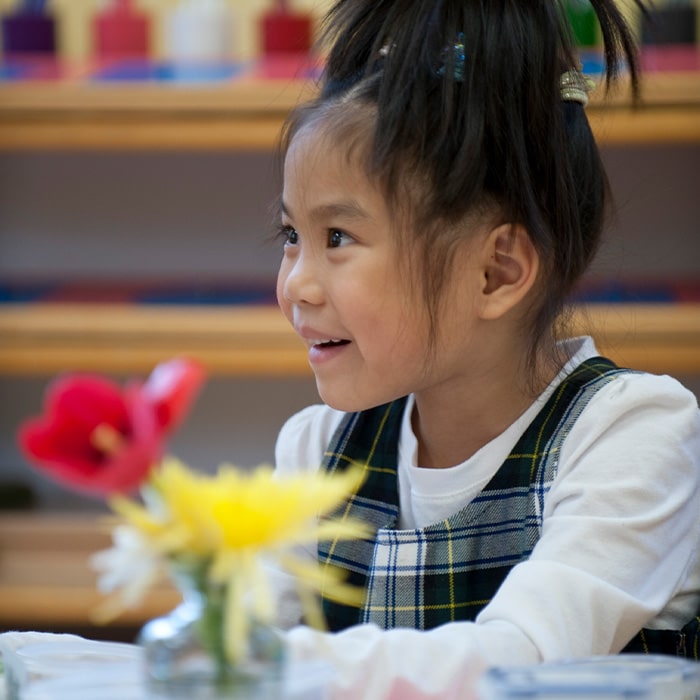
PURPOSEFUL Activity
- Environments prepared to foster activity supporting natural development
- Self-directed activities allow freedom to make mistakes and learn from them
- Confidence and self-esteem increase each successful step
